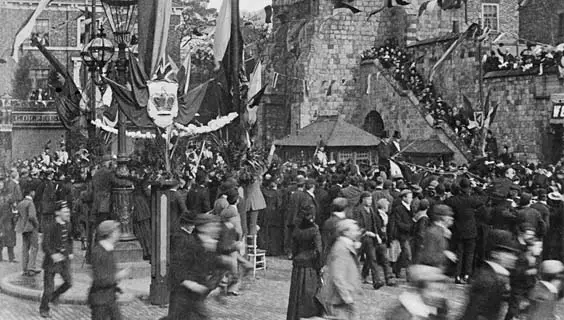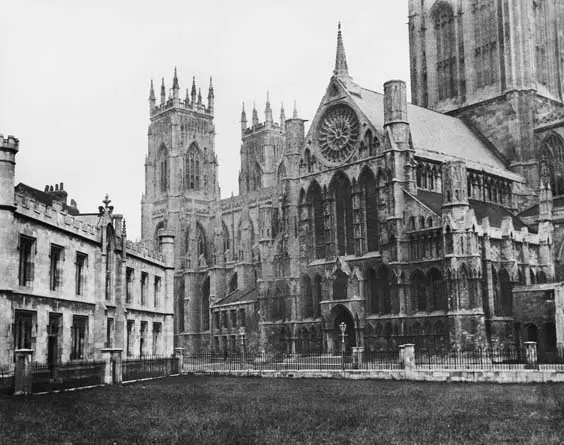Historic York – Images From the Historic England Archive

By Paul Chrystal
Taken from the Historic England Archive, a unique collection of over 12 million photographs, drawings, plans and documents covering England’s archaeology, architecture, social and local history, Historic England: York shows the city as it once was, from its streets and alleys (known locally as snickelways) to the glorious York Minster. It is a city of strong medieval character, combining grandeur and quirkiness, whose shortest street has the longest name, and where the remains of Roman and Viking life can still be seen.
York Minster, Minster Yard
A view of York Minster from around 1858, looking towards the south transept from the green on the south side of Minster Yard. They say all things come in threes; devastating fires at York Minster are no exception. The first was in 1829 when the arsonist Jonathan Martin destroyed the archbishop’s throne, the pulpit and the choir. After this the dean and chapter resolved to reinstate the lapsed post of nightwatchman. The second followed in 1840 when clockmaker William Groves left a candle burning and caused the south-west tower to go up in flames. The York Operative Protestants Association were in session nearby and declared it a Catholic hoax. The last was in 1984. Divine retribution was ruled out and an improvident lightning strike was given as the most likely cause. Sadly, the south transept roof was destroyed and the Rose window shattered.
Interior View of York Minster, Minster Yard
An interior view of York Minster, looking east across the nave. York Minster is one of seven cathedrals in the world that have their own constabulary or police force. The others are Liverpool’s Anglican Cathedral, Canterbury, Hereford, Chester Cathedral, St Peter’s Basilica in Rome (the Swiss Guard) and Washington’s National Cathedral. The phrase ‘taking a liberty’ stems from the police here when, in the thirteenth century, the lord mayor persisted in entering the Liberty of St Peter to harass the residents. The pope intervened to stop him ‘taking a liberty’. Today the job of the Minster Police is mainly security, fire watching and looking after the 380 or so sets of keys.
Station Hotel
The Royal Station Hotel, with the statue of George Leeman on the right. Part of the new station project, the Station Hotel opened in 1878 under the management of LNER. A five-storey building of yellow Scarborough brick, it featured elegant, high-ceilinged banqueting rooms and 100 large bedrooms for 14s a night. The twenty-seven-room west wing was added in 1896, named Klondyke after the US gold rush. The hotel was later renamed The Royal York after a visit by Victoria en route to Balmoral. This was York’s second Royal Station Hotel – the first had been next to the second station.
Jubbergate
A view from Parliament Street looking north-east into Jubbergate, showing No. 31–32 Parliament Street to the left, and No. 2 Jubbergate to the right. Originally it was called Joubrettagate – the street of the Bretons in the Jewish Quarter – and Jubretgate. Over the years occupants have included Webster’s kitchen- and bath-ware shop (seen here on the left), which became Pawson’s, specialists in rubber-ware, and The White Rose Inn, which became Forrington’s furnishers around 1920. Jubbergate originally extended to cover what is today Market Street as far as Coney Street. York’s first police station was here until 1880 when it moved to Clifford Street.
Bootham Bar, York
Above is a wonderful William Hayes shot of Bootham Bar in 1897, showing crowds of people celebrating Queen Victoria’s Diamond Jubilee. Opposite is the same bar, built on the remains of the Porta Principalis Dextra gateway to the Roman fortress. Bootham Bar (earlier spelt Buthum, which means at the booths and signifies the markets that used to be held here) was originally called Galmanlith. A door knocker was added to the bar in 1501 for the use of Scotsmen (and other outsiders presumably) seeking admission to the city.
The barbican came down in 1831 and the wall steps went up in 1889. A statue of Ebrauk, the pre-Roman founder of York, once stood nearby. Thomas Mowbray’s severed head was stuck here in 1405 and the Earl of Manchester bombarded the bar in 1644 during the Civil War. The barbican was removed in 1831. The removal of the barbican was due in part to complaints by residents of Clifton, ‘not fit for any female of respectability to pass through’, on account of the droppings of animals en route to the cattle market and its use as a urinal by pedestrians. The three statues on the top were carved in 1894 and feature a medieval mayor, a mason and a knight. The mason is holding a model of the restored bar.
St Mary’s Abbey Remains and St Leonard’s Hospital, Museum Gardens
St Leonard’s Hospital at the entrance to the Museum Gardens in 1854. The end of the thirteenth century saw St Leonard’s at its zenith. It looked after 230 patients, both men and women: there was free distribution of loaves and herrings at the gates during the week, thirty-three dinners, with eight more for lepers on Sundays, all washed down with fourteen gallons of beer. The 300 prisoners at the castle received a loaf on the Sabbath. Thirty elderly bedesman were given refuge in an almshouse while an orphanage took in twenty-three boys, looked after mainly by women. Two choirmasters taught thirty choristers the three ‘r’s and music. The modest staff comprised a master, thirteen brothers, four secular priests, eight sisters and six working men.
Micklegate
The rear of a tenement building in the area to the south of Micklegate. The inner arch of the former Priory gateway is visible in the wall, next to the staircase to the upper floor. A Benedictine priory, Holy Trinity Priory, was in the area now bounded by Micklegate, Trinity Lane, St Mary’s Churchyard and the city wall. The house that incorporated part of the priory’s gateway was demolished in 1854 to allow for the creation of Priory Street.
Nos 13–58 Stonegate
Looking along Stonegate, the Ye Olde Starre and its gallows sign and the Public Library at No. 13 are shown. By common consent Stonegate is one of the finest streets in England, if not Europe, and York’s first ‘foot-street’, pedestrianised in 1971 and paving the way for many more. Stonegate was once famous for its coffee shops (hence Coffee Yard). The old Roman stone paving – hence the name – survives under the cobbles complete with the central gulley for the chariots’ skid wheels. It was the Roman Via Praetoria.
The Shambles
The Shambles with the pub sign for the Shoulder of Mutton Inn (landlord M. C. Thompson) hanging in the foreground around 1880. The Shambles was originally called Haymongergate to signify the hay that was here to feed the livestock before slaughter. After that it was called Needlergate for the needles made here from the bones of slaughtered animals. It gets its present name (at first The Great Flesh Shambles) from the fleshammels – a shammel being the wooden board butchers used to display their meat on. They would throw meat on-the-turn, offal, blood and guts into the runnel in the middle of the street to add to the mess caused by chamber pot disposal from the overhanging jetties.
Terry’s of York
Terry’s moved to their purpose-built Baroque Revival building in 1930 from their Clementhorpe site, which they had occupied since 1862. By 1840 Terry’s products were being delivered to seventy-five towns all over England. Apart from boiled sweets, they also made marmalade, marzipan, mushroom ketchup and calves’ jelly. Conversation lozenges, precursors of Love Hearts (with such slogans as ‘Can you polka?’, ‘I want a wife’, ‘Do you love me?’ and ‘How do you flirt?’), were particularly popular.
Chocolate production began around 1867 with thirteen chocolate products adding to the other 380 or so confectionery and parfait lines. Before the Second World War ‘Theatre Chocolates’ were available with rustle-proof wrappers. The famous Chocolate Orange (which started life as a Chocolate Apple) was born in 1932 and at one point one in ten Christmas stockings reputedly contained a Terry’s Chocolate Orange. In the 1990s 7 million boxes of All Gold were sold in a year.

 ‘Historic York – Unique Images from the Archives of Historic England’ by Paul Chrystal is published by Amberley Publishing, £14.99,
‘Historic York – Unique Images from the Archives of Historic England’ by Paul Chrystal is published by Amberley Publishing, £14.99,
ISBN: 9781445675282



















